homemade desi ghee from malai | desi ghee recipe | homemade ghee with step wise pictorial and video method.
Desi ghee is something which is prepared in almost every Indian house and Indian meal is incomplete without desi ghee.
The present recipe of desi ghee is considered as the instant recipe because in this recipe we are making desi ghee directly from the collected malai.
most of the people make desi ghee from malai in a way that firstly they make white butter out of the malai and then make desi ghee from the white butter which is obviously a time taking process because you have to go through the two stages ; one making of white butter and second making of desi ghee.
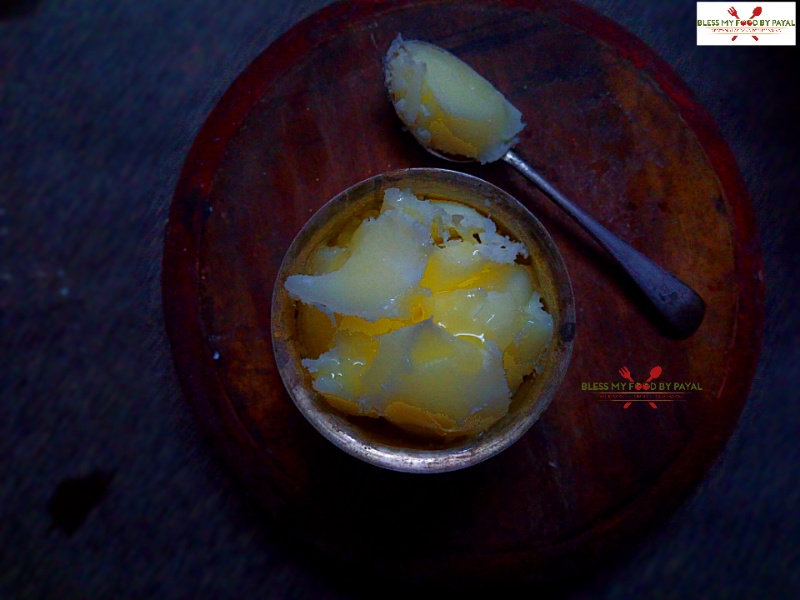
honestly speaking, since a long time we were also keep on making desi ghee by adopting the another method that is firstly making of white butter and then ghee out of the white butter. a concept was installed in our mind that the ghee which is made through the white butter is good and you get more quantity of ghee in comparison to the ghee made directly from malai.
this time we broke out our barrier and tried this way. Wondered to see no difference at all. Rather this one is easy method. You need a blender to make white butter and as a result, so much of utensils are there to wash.
not just easy, but this method is less time taking. One, because, you don’t need to give time to make white butter. Second, for churning malai to make white butter, malai needs to be brought to room temperature. Whereas there’s no need to give much time prior to begin the actual process.
so do adopt this easy method if you want only desi ghee out of malai.
Step wise pictorial recipe of homemade desi ghee from malai
1. Take malai out of the freezer and place on shelf so that it turns little soft & can be transferred to pan easily.
2. Take a wide pan or Kadai and transfer all the malai in it.
3. Place Kadai on low flame.
4. Malai will begin to melt slowly. Star stirring.
5. After some time, malai will completely melt and look like a thick milk. Keep stirring at intervals.
6. After 10 to 15 minutes, malai will turn little creamy.
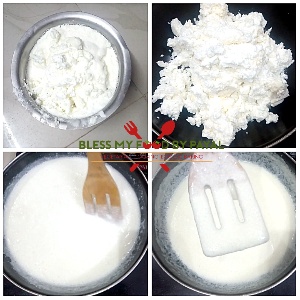
7. At this stage, from the edges, little water like liquid will begin to be seen. That is actually ghee which will begin to separate from malai. Keep stirring.
8. After 15 to 20 minutes you will find more ghee on the edges. Keep stirring.
9. After some more time, milk solids will settle down in the kadai and ghee will get separated. Switch off the flame.
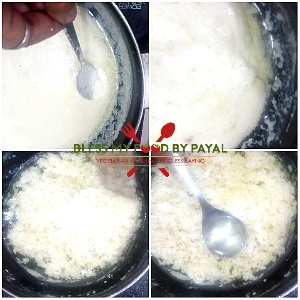
10. Now take a bowl, place a big sieve on the bowl. Then place some muslin cloth or kitchen towel in the sieve.
11. Pass the entire mixture through it.
12. Ghee will collect in the bowl and some whitish material will stay in the kitchen towel. This material is called ghee residue which still have so much of ghee in it.
13. Your ghee is ready but this is not the end yet because ghee residue still have so much of ghee in it.
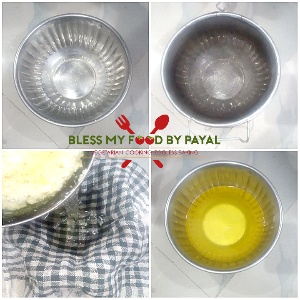
14. Transfer ghee residue back in the kadai and pour some clean water in it so that ghee residue merges well in water.
15. Place Kadai in refrigerator for 2 to 3 hours.
16. Take Kadai out of the refrigerator. There will be a whitish layers set on the surface of the water in Kadai. That is also ghee which is soft frozen due to being in refrigerator.
17. Collect that layer of ghee.
18. The water in the kadai still have some chunks of ghee as well as residue at the bottom. Time to collect that ghee too.
19. Take a small sieve and move it through the surface of the water. Ghee chunks will itself get collected into the sieve. Be careful not to go deep into water because ghee residue is settled down there. You have to collect only and only ghee.
20. Once you see that there’s no more ghee capturing in the sieve, means all ghee is collected. Stop the process. Your another batch of ghee is also abstracted hence ready.
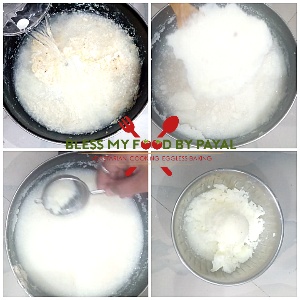
21. As what is left after filtering is not a waste but very useful, so you need to go ahead to save the leftover too.
22. Filter the water through the sieve. Ghee residue and water, which is something like butter milk, get separated.
23. Butter milk can be used to make rice or kneading dough or use it in making daals.
24. Ghee residue is very tasty and healthy and you can make several delicious recipes out of it. See below to check the various recipes made with ghee residue.
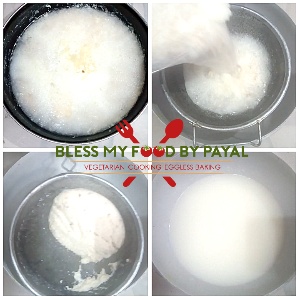
So we made ghee twice out of same malai with zero wastage.
Have a look at numerous recipes made using leftover desi ghee residue
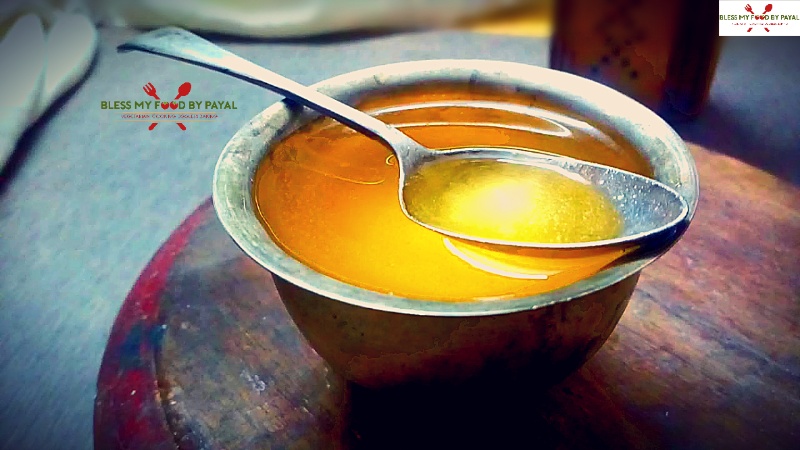
NOTE
- While you begin to collect malai, just add 1 tbsp of curd in the bowl. This will give a long life to the collected malai.
- Always put the bowl in freezer.
- Don’t keep collecting malai for an extra long days. During summers, make ghee out of malai collected for a week and during winters, don’t go beyond 15 to 20 days. Otherwise malai will begin to get rotten and also you will not get good quality of ghee residue.
- During the whole process of making desi ghee directly from malai, stirring is very important because otherwise your malai will stick to the bottom and as a result ghee will burn and turn bitter.
- Stirring is also important because you have ghee residue also in the kadai and this will become spoil and become unusable if burnt.
homemade desi ghee from malai – recipe card
homemade desi ghee from malai | desi ghee recipe | homemade ghee

Made directly from Malai, this process of making desi ghee leaves zero waste.
- Malai / Milk cream (collected for 15 days)
- Water as per need
- Take malai out of the freezer and place on shelf so that it turns little soft & can be transferred to pan easily.
- Take a wide pan or Kadai and transfer all the malai in it.
- Place Kadai on low flame.
- Malai will begin to melt slowly. Star stirring.
- After some time, malai will completely melt and look like a thick milk. Keep stirring at intervals.
- After 10 to 15 minutes, malai will turn little creamy.
- At this stage, from the edges, little water like liquid will begin to be seen. That is actually ghee which will begin to separate from malai. Keep stirring.
- After 15 to 20 minutes you will find more ghee on the edges. Keep stirring.
- After some more time, milk solids will settle down in the kadai and ghee will get separated. Switch off the flame.
-
Now take a bowl, place a big sieve on the bowl. Then place some muslin cloth or kitchen towel in the sieve.
-
Pass the entire mixture through it.
-
Ghee will collect in the bowl and some whitish material will stay in the kitchen towel. This material is called ghee residue which still have so much of ghee in it.
-
Your ghee is ready but this is not the end yet because ghee residue still have so much of ghee in it.
-
Transfer ghee residue back in the kadai and pour some clean water in it so that ghee residue merges well in water.
-
Place Kadai in refrigerator for 2 to 3 hours.
-
Take Kadai out of the refrigerator. There will be a whitish layers set on the surface of the water in Kadai. That is also ghee which is soft frozen due to being in refrigerator.
-
Collect that layer of ghee.
-
The water in the kadai still have some chunks of ghee as well as residue at the bottom. Time to collect that ghee too.
-
Take a small sieve and move it through the surface of the water. Ghee chunks will itself get collected into the sieve. Be careful not to go deep into water because ghee residue is settled down there. You have to collect only and only ghee.
-
Once you see that there’s no more ghee capturing in the sieve, means all ghee is collected. Stop the process. Your another batch of ghee is also abstracted hence ready.
-
As what is left after filtering is not a waste but very useful, so you need to go ahead to save the leftover too.
-
Filter the water through the sieve. Ghee residue and water, which is something like butter milk, get separated.
-
Butter milk can be used to make rice or kneading dough or use it in making daals.
-
Ghee residue is very tasty and healthy and you can make several delicious recipes out of it. Click here to see various recipes made with ghee residue.
- So we made ghee twice out of same malai with zero wastage.
- While you begin to collect malai, just add 1 tbsp of curd in the bowl. This will give a long life to the collected malai.
- Always put the bowl in freezer.
- Don’t keep collecting malai for an extra long days. During summers, make ghee out of malai collected for a week and during winters, don’t go beyond 15 to 20 days. Otherwise malai will begin to get rotten and also you will not get good quality of ghee residue.
- During the whole process of making desi ghee directly from malai, stirring is very important because otherwise your malai will stick to the bottom and as a result ghee will burn and turn bitter.
- Stirring is also important because you have ghee residue also in the kadai and this will become spoil and become unusable if burnt.
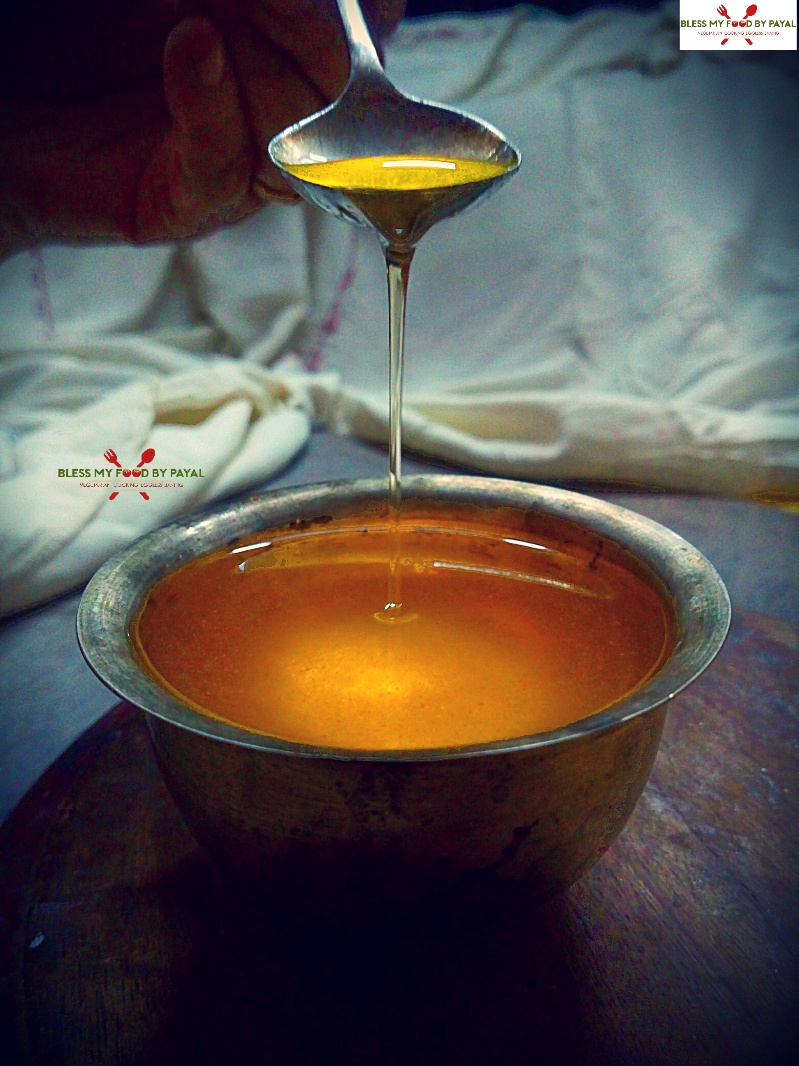
Pingback: Kulthi Ki Khichdi Recipe
Pingback: Authentic Kashmiri Pulao Recipe
Pingback: Paneer Chingari Recipe
Pingback: Homemade Chyawanprash Recipe
Pingback: Homemade Baby Biscuits Recipe
Pingback: How to Make Authentic Hyderabadi Paneer Curry
Pingback: Ghee residue coconut Ladoo
Pingback: Meethi Seviyan Recipe Without Milk in Microwave
Pingback: Homemade Dhaba Style Paneer Masala Recipe
Pingback: Rice flour ladoo recipe | rice flour peda recipe
Pingback: Authentic Panchamrit recipe as per Hindu Scriptures
Pingback: Baked Besan Ladoo recipe - only 2 tbsp ghee used
Pingback: Vegan Almond Biscotti recipe
Pingback: Baked Mathri Recipe - Air Fryer and Oven methods
Pingback: Dum Aloo Biryani Recipe
Pingback: Eggless Fennel seeds cake recipe | eggless sounf cake recipe
Pingback: Masala Gur Recipe | Masala Jaggery Recipe
Pingback: Shahi Dal Maharani recipe | Resturant style dal Maharani recipe
Pingback: Moong Dal Halwa recipe with less ghee
Pingback: Authentic kashmiri shufta recipe
Pingback: Pakang tod Mithai recipe | palangtod sweet recipe of pathankot
Pingback: Eggless Desi Ghee cake recipe indian style
Pingback: Authentic Dal Makhani recipe restaurant style
Pingback: Gur Gatta recipe | Jaggery Honeycomb recipe
Pingback: Gond (edible gum) biscuits recipe - Bless My Food By Payal
Pingback: Badam barfi | Almond burfi recipe
Pingback: Panchakjjaya Prasadam | Panchakjjaya recipe
Pingback: Instant kalakand in microwave
Pingback: Methi Seviyan without milk | sweet vermicelli
Pingback: Eggless ghee residue cake recipe
Pingback: Ajwain Atta Cookies | Ajwain cookies recipe | bless my food by payal
Pingback: Navratan Pulao Recipe - Bless my food by payal
Pingback: Jammu special Sasrut recipe | Dogra wedding recipe sasrut
Pingback: how to make suji ka halwa in microwave oven | suji ka halwa in microwave
Pingback: vermicelli kheer with custard powder | how to make semiya custard
Pingback: Authentic mathura ke pede recipe | Bless My Food by Payal
Pingback: Bawe wali Barfi Jammu special | Famous Barfi of Bahu Fort Jammu
Pingback: Besan Nankhatai Recipe | Besan Khatai Recipe | Bless My Food
Pingback: Green moong dal recipe without tomato - Bless My Food By Payal
Pingback: Coconut cookies without eggs | crunchy coconut cookies | eggless coconut biscuits recipe - Bless My Food By Payal
Pingback: Layered Gujia recipe | baked Gujia recipe | how to make mawa gujia without mould - Bless My Food By Payal
Pingback: Jammu wale naan | how to make chole wale naan | jammu street food naan - Bless My Food By Payal
What a fabulous and easy recipe for making homemade ghee without the tedious process of making makhan first and then ghee from it.
Would love to try this sometimes as we don’t use full fat milk anymore.
Lived the detailed recipe with lots of helpful tips to make it perfect way.
Thank you for sharing.
Happy to see you really liked it. Thank you heaps for the comment.
Pingback: Khoya matar makhana recipe | khoya matar makhana curry | khoya matar makhana using leftover desi ghee residue - Bless My Food By Payal
Pingback: jammu special sund | sundh recipe | sund panjiri recipe - Bless My Food By Payal
Pingback: Oats khoya Ladoo | oats laddu with ghee residue | oats Ladoo recipe - Bless My Food By Payal
Pingback: 7 cup barfi recipe | 7 cup cake recipe | 7 cup burfi - Bless My Food By Payal
Pingback: 10 recipes using leftover desi ghee residue | desi ghee residue recipes | how to use ghee residue
Pingback: Dalia Ladoo | Broken Wheat Ladoo - Bless My Food By Payal
Pingback: suji ka paratha | sooji paratha | rava paratha - Bless My Food By Payal
Pingback: custard flavoured paneer barfi from leftover ghee residue | paneer barfi | custard burfi - Bless My Food By Payal
Pingback: jammu chocolate | jammu chocolate recipe | how to make jammu chocolate at home - Bless My Food By Payal
Pingback: gur wale chawal | gur ke chawal | jaggery rice recipe - Bless My Food By Payal
Pingback: khoya paneer | khoya paneer recipe | how to make khoya paneer - Bless My Food By Payal
Pingback: coconut and cornflakes parantha | nariyal aur cornflakes ka parantha - Bless My Food By Payal
Pingback: thekua | thekua recipe | bihari khasta thekua recipe - Bless My Food By Payal
Pingback: Tiranga Kesri Halwa | Rava Kesri recipe | Indian Semolina Pudding
Pingback: Shahi Tukda
Pingback: Kaja | khaja sweet | madatha kaja recipe - Bless My Food By Payal
Pingback: Amul Butter Recipe
Pingback: Dry Fruit Madra - Sugar free dessert
Pingback: Mughlai Shahi Paneer Korma
Pingback: Louki Aur Nariyal Ki Barfi - Bless My Food By Payal
Pingback: Doodh peda | milk peda recipe - Bless My Food By Payal
Pingback: dates laddu | dates ladoo recipe | khajur laduu | dates and nuts laddu recipe - Bless My Food By Payal
Pingback: kaddu ka halwa | pumpkin halwa recipe - Bless My Food By Payal
Pingback: methi puri recipe, methi ki puri, how to make methi puri, methi poori
Pingback: farsi puri recipe | gujarati farsi puri | how to make farsi puri | farsi poori - Bless My Food By Payal
Pingback: Rajasthani Khoba Roti Recipe
Pingback: Meethe Chawal
Pingback: hydrabadi veg dum biryani | veg dum biryani | hydrabadi biryani - Bless My Food By Payal
Pingback: Lehsuni palak | lehsuni palak ka saag | dhaba style lehsuni palak recipe - Bless My Food By Payal
Pingback: gajar ka halwa with khoya | gajar ka halwa with mava | gajar halwa without milk - Bless My Food By Payal
Pingback: gajar ka halwa with milk | gajar ka halwa | gajar ka halwa without khoya - Bless My Food By Payal
Pingback: gajar ki barfi with desi ghee residue | carrot Barfi | gajar burfi recipe - Bless My Food By Payal